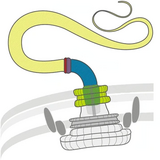| Part of a series on |
| Microbial and microbot movement |
|---|
 |
| Microswimmers |
| Molecular motors |
A microswimmer is a microscopic object with the ability to move in a fluid environment.[1] Natural microswimmers are found everywhere in the natural world as biological microorganisms, such as bacteria, archaea, protists, sperm and microanimals. Since the turn of the millennium there has been increasing interest in manufacturing synthetic and biohybrid microswimmers. Although only two decades have passed since their emergence, they have already shown promise for various biomedical and environmental applications.[1]
Given the recent nature of the field, there is yet no consensus in the literature for the nomenclature of the microscopic objects this article refers to as "microswimmers". Among the many alternative names such objects are given in the literature, microswimmers, micro/nanorobots and micro/nanomotors are likely the most frequently encountered. Other common terms may be more descriptive, including information about the object shape, e.g., microtube or microhelix, its components, e.g., biohybrid, spermbot,[2] bacteriabot,[3] or micro-bio-robot,[4] or behavior, e.g., microrocket, microbullet, microtool or microroller. Researchers have also named their specific microswimmers e.g., medibots,[5] hairbots,[6] iMushbots,[7] IRONSperm,[8] teabots,[9] biobots,[10] T-budbots,[11] or MOFBOTS.[12][1]
- ^ a b c Bunea, Ada-Ioana; Taboryski, Rafael (2020). "Recent Advances in Microswimmers for Biomedical Applications". Micromachines. 11 (12): 1048. doi:10.3390/mi11121048. PMC 7760273. PMID 33261101.
 Material was copied from this source, which is available under a Creative Commons Attribution 4.0 International License.
Material was copied from this source, which is available under a Creative Commons Attribution 4.0 International License.
- ^ Medina-Sánchez, Mariana; Schwarz, Lukas; Meyer, Anne K.; Hebenstreit, Franziska; Schmidt, Oliver G. (2016). "Cellular Cargo Delivery: Toward Assisted Fertilization by Sperm-Carrying Micromotors". Nano Letters. 16 (1): 555–561. Bibcode:2016NanoL..16..555M. doi:10.1021/acs.nanolett.5b04221. PMID 26699202.
- ^ Schauer, Oliver; Mostaghaci, Babak; Colin, Remy; Hürtgen, Daniel; Kraus, David; Sitti, Metin; Sourjik, Victor (2018). "Motility and chemotaxis of bacteria-driven microswimmers fabricated using antigen 43-mediated biotin display". Scientific Reports. 8 (1): 9801. Bibcode:2018NatSR...8.9801S. doi:10.1038/s41598-018-28102-9. PMC 6023875. PMID 29955099.
- ^ Magdanz, Veronika; Sanchez, Samuel; Schmidt, Oliver G. (2013). "Development of a Sperm-Flagella Driven Micro-Bio-Robot". Advanced Materials. 25 (45): 6581–6588. Bibcode:2013AdM....25.6581M. doi:10.1002/adma.201302544. PMID 23996782. S2CID 5125033.
- ^ Srivastava, Sarvesh Kumar; Medina-Sánchez, Mariana; Koch, Britta; Schmidt, Oliver G. (2016). "Medibots: Dual-Action Biogenic Microdaggers for Single-Cell Surgery and Drug Release". Advanced Materials. 28 (5): 832–837. Bibcode:2016AdM....28..832S. doi:10.1002/adma.201504327. PMID 26619085. S2CID 40955542.
- ^ Singh, Ajay Vikram; Dad Ansari, Mohammad Hasan; Dayan, Cem Balda; Giltinan, Joshua; Wang, Shuo; Yu, Yan; Kishore, Vimal; Laux, Peter; Luch, Andreas; Sitti, Metin (2019). "Multifunctional magnetic hairbot for untethered osteogenesis, ultrasound contrast imaging and drug delivery". Biomaterials. 219: 119394. doi:10.1016/j.biomaterials.2019.119394. PMID 31382208. S2CID 199451792.
- ^ Bhuyan, Tamanna; Singh, Amit Kumar; Dutta, Deepanjalee; Unal, Aynur; Ghosh, Siddhartha Sankar; Bandyopadhyay, Dipankar (2017). "Magnetic Field Guided Chemotaxis of i Mushbots for Targeted Anticancer Therapeutics". ACS Biomaterials Science & Engineering. 3 (8): 1627–1640. doi:10.1021/acsbiomaterials.7b00086. PMID 33429648.
- ^ Magdanz, Veronika; Khalil, Islam S. M.; Simmchen, Juliane; Furtado, Guilherme P.; Mohanty, Sumit; Gebauer, Johannes; Xu, Haifeng; Klingner, Anke; Aziz, Azaam; Medina-Sánchez, Mariana; Schmidt, Oliver G.; Misra, Sarthak (2020). "IRONSperm: Sperm-templated soft magnetic microrobots". Science Advances. 6 (28): eaba5855. Bibcode:2020SciA....6.5855M. doi:10.1126/sciadv.aba5855. PMC 7450605. PMID 32923590.
- ^ Bhuyan, Tamanna; Dutta, Deepanjalee; Bhattacharjee, Mitradip; Singh, Amit Kumar; Ghosh, Siddhartha Sankar; Bandyopadhyay, Dipankar (2019). "Acoustic Propulsion of Vitamin C Loaded Teabots for Targeted Oxidative Stress and Amyloid Therapeutics". ACS Applied Bio Materials. 2 (10): 4571–4582. doi:10.1021/acsabm.9b00677. PMID 35021416. S2CID 203945671.
- ^ Bunea, Ada-Ioana; Glückstad, Jesper (2019). "Strategies for Optical Trapping in Biological Samples: Aiming at Microrobotic Surgeons" (PDF). Laser & Photonics Reviews. 13 (4). Bibcode:2019LPRv...1300227B. doi:10.1002/lpor.201800227. S2CID 128326068.
- ^ Bhuyan, Tamanna; Simon, Anitha T.; Maity, Surjendu; Singh, Amit Kumar; Ghosh, Siddhartha Sankar; Bandyopadhyay, Dipankar (2020). "Magnetotactic T-Budbots to Kill-n-Clean Biofilms". ACS Applied Materials & Interfaces. 12 (39): 43352–43364. doi:10.1021/acsami.0c08444. PMID 32864951. S2CID 221383266.
- ^ Wang, Xiaopu; Chen, Xiang-Zhong; Alcântara, Carlos C. J.; Sevim, Semih; Hoop, Marcus; Terzopoulou, Anastasia; De Marco, Carmela; Hu, Chengzhi; De Mello, Andrew J.; Falcaro, Paolo; Furukawa, Shuhei; Nelson, Bradley J.; Puigmartí-Luis, Josep; Pané, Salvador (2019). "MOF-Based Microrobots: MOFBOTS: Metal–Organic-Framework-Based Biomedical Microrobots (Adv. Mater. 27/2019)". Advanced Materials. 31 (27). Bibcode:2019AdM....3170192W. doi:10.1002/adma.201970192. S2CID 198797318.
© MMXXIII Rich X Search. We shall prevail. All rights reserved. Rich X Search
